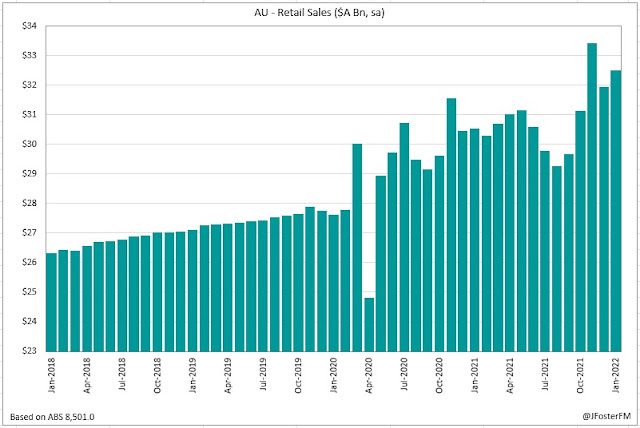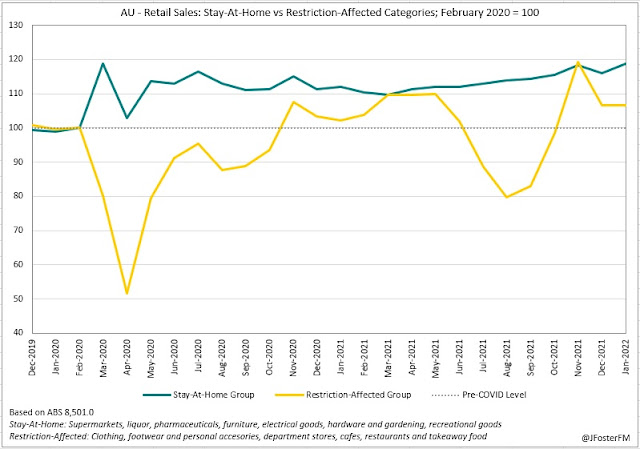Australian retail sales held up far better than expected during January's Omicron wave rising by 1.8% in the month. Food sales led the rise, likely driven by reduced discounting when supply shortages hit, but non-food sales also advanced. Volatility in spending levels and patterns has become less pronounced as the pandemic has progressed, with the vaccine rollout ending the need for lockdowns.
Retail Sales — January | By the numbers
- National retail sales advanced by 1.8%m/m in January to $32.5bn, significantly better than the 0.3% rise anticipated and rebounding from December's 4.4% pullback.
- 12-month retail sales lifted to 6.4% from 4.8%.
Retail Sales — January | The details
Australian retail sales defied the surge in the Omicron wave through January to post a 1.8% rise in the month, to be 6.4% higher over the year and remaining well above its pre-Covid trend.
Retail sales had pulled back in December (-4.4%) after hitting a record high in November, with spending being brought forward in the lead-up to Christmas due to Black Friday sales and as people sought to get ahead of supply issues. Despite coming off this lower base, January sales were still the second-highest on record.
Food sales lifted by 2.2% in the month, matching the rise seen in December, and drove the headline increase. Non-food sales advanced by 1.5%m/m after pulling back by 8.5% in December.
Being nominal sales, the data includes the effects of price changes. Given the disruptions to supply chains, product shortages hit the major supermarkets during the Omicron surge. Accordingly, the supply/demand mismatch likely saw discounting cut back, in turn putting upward pressure on food prices. Note that supermarket sales lifted by 3% in January, their fastest month-on-month rise since the initial wave of the pandemic.
Australia's very high levels of Covid vaccination meant that lockdowns were not brought in during the Omicron wave. This had implications on the mix of spending in January compared to previous waves.
The chart below has been constructed by separating spending categories into two groups: "stay-at-home" and "restriction-affected". The stay-at-home group, which includes categories that tend to see spending rise during lockdowns, lifted in January by 2.4%; an outcome likely to have been boosted by precautionary behaviour with people trying to avoid falling ill. Unlike in the two major prior waves, sales in the restriction-affected group (including categories associated with going out) plunged amid lockdowns. During Omicron they held flat in January (0.2%). Overall, this shows the fading effects of the pandemic on the level and composition of spending, with the vaccination rollout enabling the health response of the authorities to change.
One area that remains very dynamic to Covid is the online area. Sales in the segment saw a resurgence rising by 7.9% in January after falling in recent months post the Delta lockdowns. Many people, either in isolation or avoiding going out, were shopping online in January. Non-food sales drove the rise with an 11.1% surge.
All states saw retail sales rise in the month, with Western Australia, unaffected by Omicron due to its border closure, surging by 4.7%. Nonetheless, even with Omicron spreading, sales advanced in New South Wales (1%), Victoria (2.5%), Queensland (0.4%), South Australia (3.1%) and Tasmania (0.7%).
Retail Sales — January | Insights
A resilient result for retail sales in January considering this was amid the surge in the Omicron wave. The result was likely boosted reduced discounting at supermarkets due to supply issues. Online sales rose sharply and remain dynamic to developments with the pandemic around caseloads and isolation rules. In terms of the outlook, the high level of accumulated savings retained by households reported in Q4's national accounts (see here), the tightening labour market, the large pipeline of residential construction work and eased Covid restrictions are all supportive factors.









